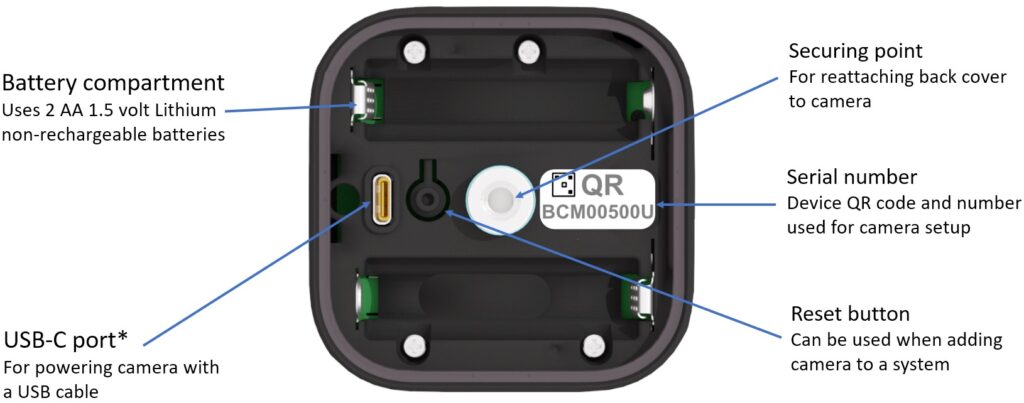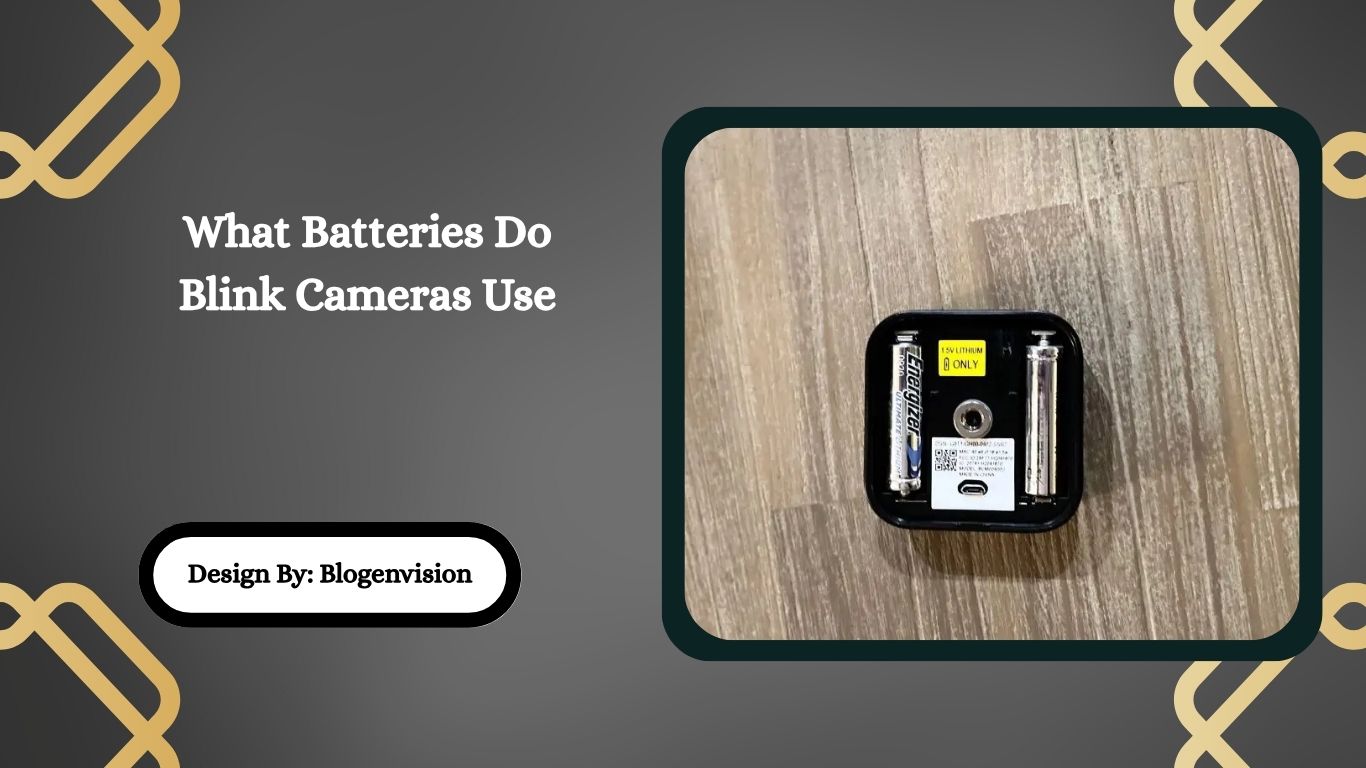What Batteries Do Blink Cameras Use – Complete Power Guide!
Blink cameras use AA 1.5V non-rechargeable lithium batteries, typically Energizer Ultimate Lithium. They provide long life and consistent performance. Alkaline and rechargeable batteries are not recommended due to voltage and power limitations.
If you own a Blink security camera or are considering getting one, knowing which batteries to use is essential for performance, convenience, and long-term reliability. Blink cameras are popular for their wire-free, smart-home security features, but many users often ask: “What batteries do Blink cameras use?”
This guide breaks down everything you need to know — from compatible battery types for each model, how long they last, troubleshooting power issues, and pro tips to maximize battery life.
What Batteries Do Blink Cameras Use?

Quick Answer:
Most Blink cameras, including the Blink Outdoor, Blink Indoor (2nd Gen), and Blink XT2, use two AA lithium batteries — specifically non-rechargeable 1.5V AA lithium batteries such as Energizer Ultimate Lithium.
Rechargeable and alkaline batteries are not recommended, as they can cause issues with power delivery, performance, and longevity.
Battery Type Breakdown by Blink Model
Here’s a detailed breakdown of what batteries are used in each Blink camera model:
| Blink Camera Model | Battery Type | Quantity Required | Recommended Brand |
| Blink Outdoor (3rd Gen) | 1.5V AA Lithium (non-rechargeable) | 2 | Energizer Ultimate Lithium |
| Blink Indoor (2nd Gen) | 1.5V AA Lithium (non-rechargeable) | 2 | Energizer Ultimate Lithium |
| Blink XT2 | 1.5V AA Lithium (non-rechargeable) | 2 | Energizer Ultimate Lithium |
| Blink XT | 1.5V AA Lithium (non-rechargeable) | 2 | Energizer Ultimate Lithium |
| Blink Indoor (1st Gen) | 1.5V AA Lithium (non-rechargeable) | 2 | Energizer Ultimate Lithium |
| Blink Video Doorbell | 2 x AA 1.5V Lithium OR hardwired | 2 (or hardwired) | Energizer Ultimate Lithium |
| Blink Mini | No batteries – requires USB power | 0 | N/A |
Can You Use Rechargeable or Alkaline Batteries in Blink Cameras?
No. Blink strongly advises against using alkaline or NiMH rechargeable batteries due to the following reasons:
- Voltage drop-off: Alkaline batteries may show full power but drop voltage quickly under load, triggering “low battery” alerts or random shutoffs.
- Insufficient peak current: Rechargeable batteries often can’t handle the sudden power draw when Blink cameras activate motion detection or night vision.
- Reduced battery life: Even if they power the device briefly, they won’t last long and could damage the camera’s internals.
For best results, always use non-rechargeable AA lithium batteries.
Why Energizer Ultimate Lithium Batteries Are Recommended?
Blink officially recommends Energizer Ultimate Lithium AA 1.5V batteries for a few important reasons:
- Consistent voltage output
- High peak current delivery
- Long shelf life (up to 20 years)
- Extreme temperature resistance (-40°F to 140°F)
- Leak-proof design
These qualities make them ideal for outdoor security environments where stability and durability are crucial.
How Long Do Blink Batteries Last?
On average, Blink claims a battery life of up to two years with standard use. However, actual battery life depends on:
- Motion activity frequency
- Camera placement and environment (indoor/outdoor)
- Wi-Fi strength
- Video clip length and resolution
- Night vision or infrared use
Realistic Battery Lifespan Estimates:
| Usage Type | Estimated Battery Life |
| Light Activity (few clips per day) | 18–24 months |
| Moderate Activity | 12–18 months |
| Heavy Activity (constant motion) | 6–12 months |
| Poor Wi-Fi Signal | Shortens lifespan significantly |
How to Check Blink Camera Battery Levels?
You can monitor your Blink camera’s battery status via the Blink Home Monitor App:
- Open the Blink app.
- Select the camera.
- Tap the gear icon to access device settings.
- Scroll to Battery — it will show either “OK” or “Needs Replacement.”
Note:
The app does not show a percentage, only an overall status. You’ll typically get a notification when the battery is low.
Troubleshooting Blink Battery Issues
If your Blink camera isn’t turning on or showing “Low Battery,” try the following:
- Confirm Battery Type: Ensure you’re using non-rechargeable AA lithium batteries, not alkaline or NiMH.
- Check Battery Orientation: Remove and reinsert the batteries properly. The battery contacts must be clean and aligned.
- Replace With Fresh Batteries: Even “new” batteries may be old or improperly stored. Use a fresh, sealed pack of Energizer Ultimate Lithium.
- Power Cycle the Camera: Remove batteries, wait 10 seconds, and reinsert them.
- Wi-Fi Signal Check: A weak signal can drain batteries fast. Move your router or use a Blink Sync Module for better range.
Can You Use External Power for Blink Cameras?
Yes, but only certain models support it:
- Blink Mini: Uses USB power (comes with adapter)
- Blink Outdoor & Indoor (3rd Gen): Can be powered with Blink’s USB Power Adapter accessory (sold separately)
- Blink Video Doorbell: Can be hardwired to your existing doorbell wiring or run on batteries
External power is ideal if:
- Your camera sees heavy motion activity
- You don’t want to replace batteries often
- Your camera is in a hard-to-reach spot
Battery Saving Tips for Blink Users
Want to extend your battery life? Here’s how:
- Adjust Motion Sensitivity: Lower the motion sensitivity in the app to reduce unnecessary triggers.
- Reduce Clip Length: Shorter video clips mean less power draw per activation.
- Turn Off Audio (if not needed): Recording audio uses extra battery.
- Optimize Wi-Fi Signal: Strong signal = less battery drain. Use a Blink Sync Module to improve connectivity.
- Disable Night Vision in Daylight: If your camera is always in a well-lit area, turn off IR night vision.
Where to Buy Blink-Compatible Batteries?

Here are safe and trusted places to buy AA lithium batteries:
- Amazon (Official Energizer Store)
- Walmart / Target
- Home Depot / Lowe’s
- Best Buy
- B&H Photo Video (camera-specific retailer)
Avoid suspiciously cheap brands — they may lack the power performance needed for Blink devices.
Warning: Don’t Mix Battery Types
Always replace both AA batteries at the same time and never mix brands or battery types. Mixing old and new batteries or lithium with alkaline can cause:
- Leaks
- Voltage irregularities
- Damage to internal camera circuits
FAQs:
1: Can I use alkaline batteries temporarily in Blink cameras?
While you can, it’s not recommended. Alkaline batteries can’t provide stable power under load, leading to short battery life or frequent disconnection. Stick with lithium for best results.
2: Will using rechargeable batteries void the warranty?
Using non-recommended power sources, including rechargeables, may violate Blink’s terms and affect warranty coverage. Always follow manufacturer battery guidelines to avoid damaging the device.
3: Why does my Blink camera say “low battery” after replacing with new batteries?
Check if you used alkaline or rechargeable batteries instead of lithium. Also, ensure proper orientation and battery contacts. If the issue persists, try a fresh set of Energizer Ultimate Lithium.
4: Can extreme weather affect Blink camera batteries?
Yes. Lithium batteries perform better than alkaline in cold or hot environments, but extremely low temperatures (below -20°C) may still affect performance. Consider placement or external power solutions in harsh climates.
5: How do I know when it’s time to replace Blink batteries?
The Blink app notifies you when batteries are low. Additionally, performance drops (missed recordings, delayed motion alerts) can signal the need for replacement even before an alert is triggered.
Conclusion
Using the correct batteries is crucial for your Blink camera’s reliability and performance. Always use 1.5V AA non-rechargeable lithium batteries, such as Energizer Ultimate Lithium, to ensure optimal functionality and long battery life. Avoid alkaline and rechargeable alternatives, as they can’t provide the necessary voltage or stability. Monitor battery levels via the Blink app and follow smart usage tips to extend battery lifespan. With the right battery strategy, your Blink system will remain dependable, efficient, and ready to protect your home around the clock.







